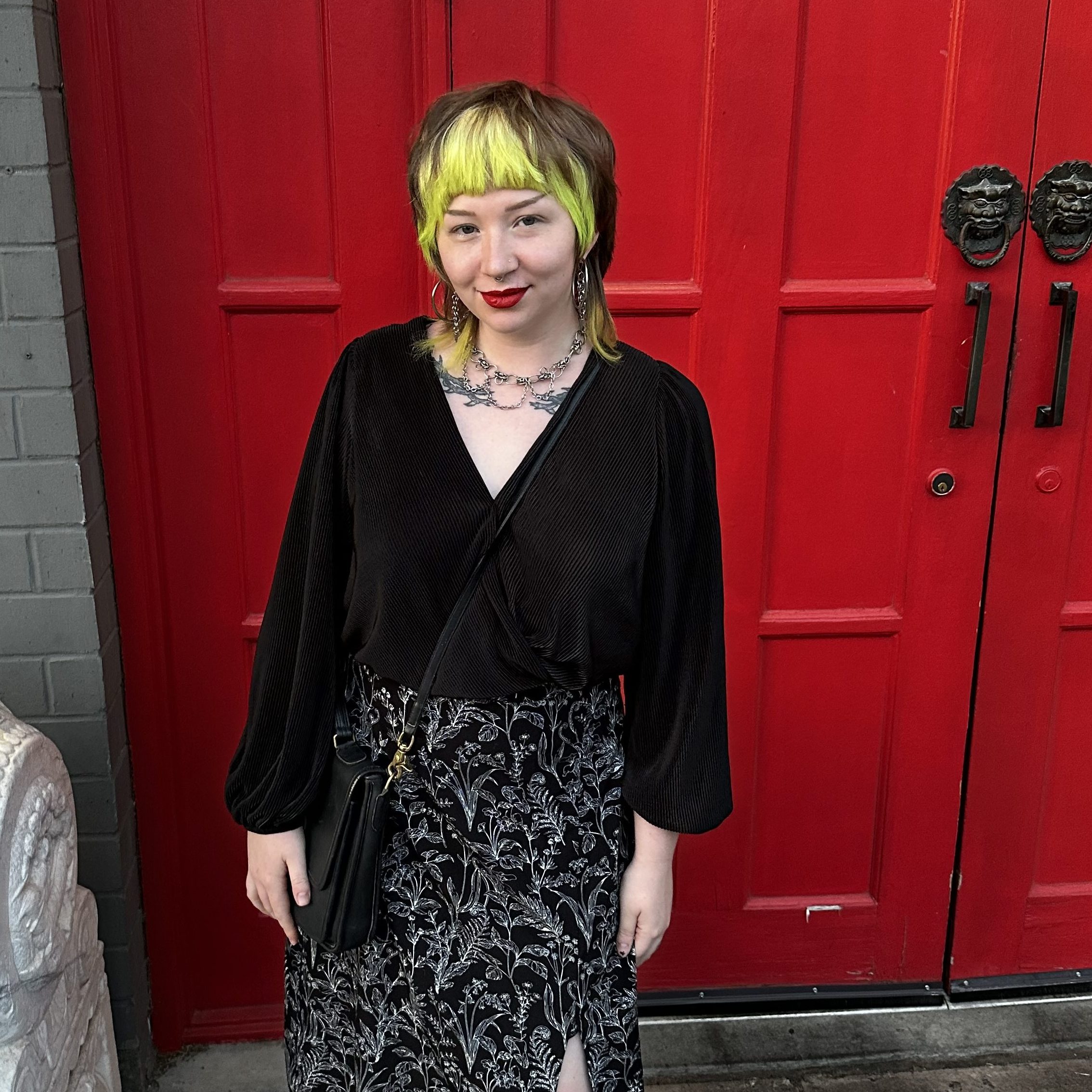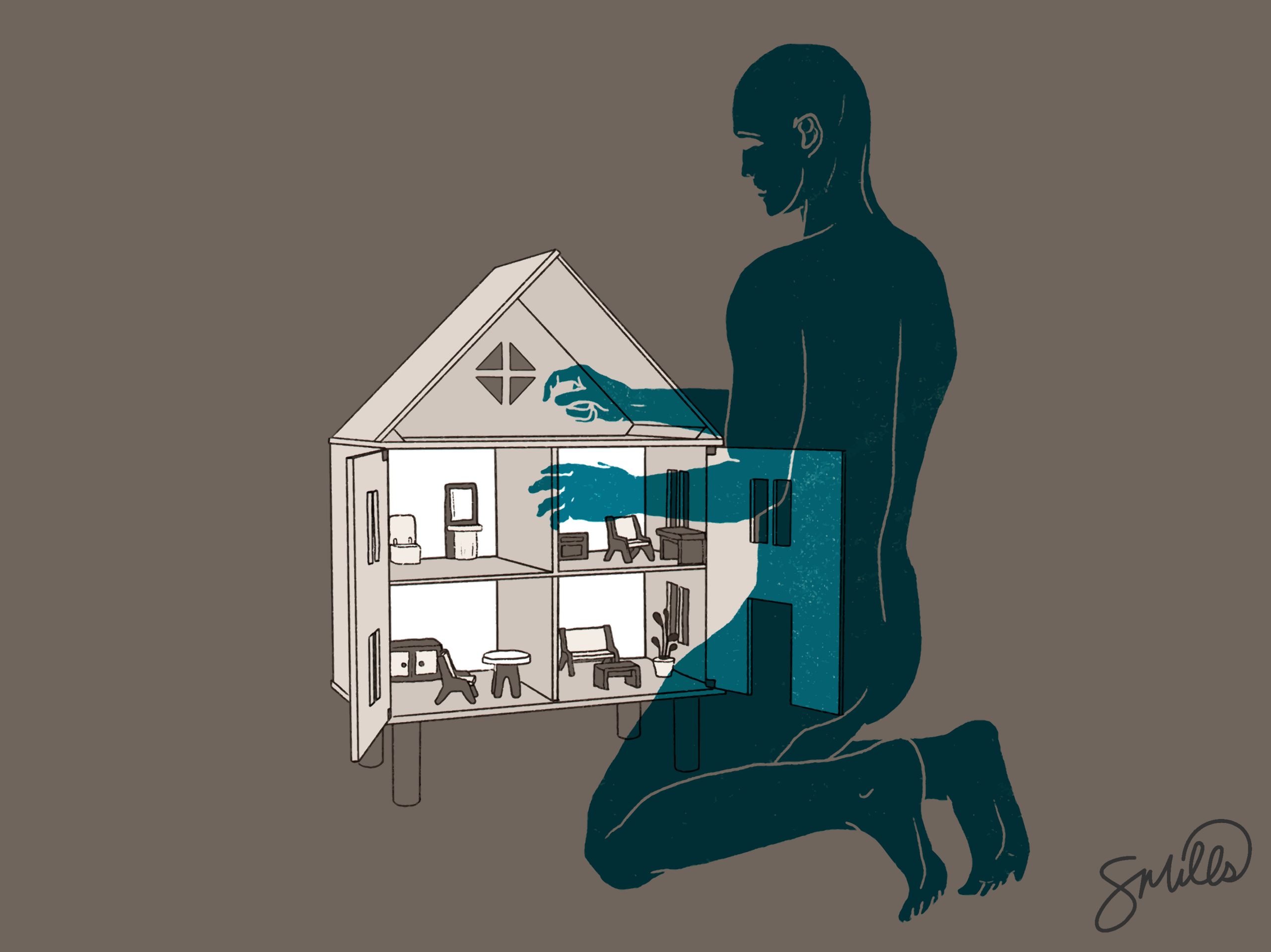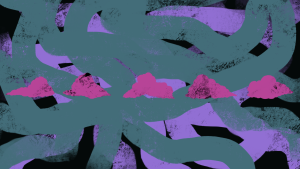She gets choked.
1: Are you okay?
2: Sure. I’m fine. (Swallows.)[…]
2: I watched an entire audience get on their feet tonight for a show that had a dog in it.
1: Yes. I /
2: / Real-life babies. Like that’s the only pulse we can find. Silent women in hot pants told to sing like canaries in this fucking day and age are you kidding me? With Trump in, with the monstrosities going down, the world is cracking open and what I just saw is meant to heal us? We should be screaming, we should be speaking in tongues, in a fit, in a fucking – rage, naked, raging, arms open, screaming at the sky – There should not be a dog. There should not be a fucking dog. Not unless you’re going to cut its fucking tongue out.[…]
1: It’s done very well at the box office.
2: Of course it has.
1: It’s going into the West End.
2: Of course it is.
1: The critics have loved it.
2: And in what other realm of life would a twenty-four-year-old woman let a bunch of old white guys tell her what’s good to do on a Friday night? Let alone what might defibrillate her soul.[…]
1: What else do you want?
Dialogue from “The Writer”
2: I want the world to change shape.
I think that there’s something useful in using “The Writer” by Ella Hickson, a play produced at Steep Theatre in Chicago last September, as a case study. Its critique—of capitalist, patriarchal institutions, and more specifically, of the artist’s role, our complicity within institutions that perpetuate violence and kill imagination—is both revolutionarily incomplete and, despite that, one of the most thorough critiques of imperial theater we can see in a Chicago theater. Which is fucking disappointing.
I say it’s fucking disappointing as a writer (but not the Writer), a director (but not the Director) and I think what I call myself at this point is a site-specific performance artist. I mean that I don’t have institutions backing me and I get pretty mad about how amoral theater companies are, ecstatic about how revolutionary theater can be, and all of that might be why I got so very pissed off watching “The Writer”; my anger, righteous for weeks after, soon hollowed out into a smothering ontological “why?”
This question plagues theater as a medium; no play or performance is exempt from its interrogation as almost any play requires an absurd amount of time and money to produce to remain even remotely labor-conscious (my partner once walked out from a rehearsal with me, the first they ever saw, and after a long enough silence that the door of the rehearsal space was out of earshot, they said, “nothing happened.” I was paid $60 for this show.) What sets Hickson’s piece apart as worthy of further examination from other plays that discuss these systems is its narrative construction and its architectural motifs: this play—built like a furious, haunted dollhouse—treats perspective like a magic trick. We fit inside the house at first and can see its six rooms, its two wings, and its pieces of creepy, surreal furniture, but as we sit in it, we find ourselves outgrowing it—it shrinks around us, crushing us until we have to leave and perceive the other house that created this play: the extractive Theatre, a world separated and cultivated for an audience to judge by its closeness to “reality,” a cultural construction.
Specifically, I want to talk about how Hickson uses psychological realism and decimates it as a foundation of western theater.
Psychological realism might be a new phrase to you, but if you’re reading this, you’re probably deeply familiar with the genre. If you’ve seen a play at any theater or any movie, it was likely at the very least deeply influenced by psychological realism. “Oppenheimer” is psychological realism; “Barbie” too. “The King’s Speech” is. “The Glass Menagerie,” “Death of A Salesman,” and on and on. Even “Everything Everywhere All At Once.” They might have some flair to them, but the underpinning is a set of individual humans whose interiority (their realistic psychologies) drive forth the story and how their will is what influences the world. The basic idea of realism is hidden away in the name: “this is the reality of the situation” says realism. And that’s that.
This is a particularly pernicious propaganda, one so insidious that even the most capable storytellers sometimes miss the obvious question: whose conception of reality is being recreated? (What even is “reality?”) And, maybe just as important, why are power play and conflict key features in these realities?
In the play, after that initial dialogue in the theater is revealed to be a scene written by the eponymous Writer, we’re suddenly in a talkback about the scene we watched (lord, please no). The Writer enters the most tedious, strained public conversation with the Director who insists on the intellectual dialectic of their conversations and her plays being the driver of drama:
DIRECTOR. If you think this version is self-indulgent you should have seen the first draft.
WRITER. I’m not sure emotive, personal expression and self-indulgence are necessarily the same thing. I find fifteen pages of finely wrought, cold, rational, academic dialectic self-indulgent. Just because it’s a woman standing on stage saying how she feels /
DIRECTOR. / How she feels, exactly. This entire movement at the moment is so fucking self–
WRITER. As opposed to how he thinks. You don’t think we’re saturated with how ‘he thinks’. I mean the entire structure of the Western world is organised on the principle of how ‘he thinks’.
DIRECTOR. Exactly ‘the world’ – it’s a broader perspective,
it’s accessible to – it’s not just one person’s endless, self-involved perspective on their own anguish.
WRITER. Hamlet.
DIRECTOR. Which uses the personal as a political /
WRITER. / So why can’t the same be true here?
FEMALE ACTOR. It doesn’t feel like a rant – to play it.Weird – long pause – no one seems to have an answer.
DIRECTOR. Any more questions from the audience?
“The entire structure of the Western world is organised on how ‘he thinks.’”
In other words, this theater, in Chicago, is how ‘he thinks’ as well.
I think it’s very easy to be romantic about theater if you’ve made it before. When we drink the Kool-Aid, we enter a long process of learning: physical embodiment, speaking, vulnerability, collaboration, and spacemaking. All of that, when it’s developed and focused, can transform a mundane experience into something transcendent, spiritual even. It’s why people so desperately claw their way into the industrial cliques and arts institutions that deign resources and power upon individuals—because when theater artists find a project and the chemistry with our collaborators is right and the sun strikes the ground outside of our doors just right, then something impossible happens and the body responds with the physical state of awe and wonder and all things condense into the singular moment of here-and-now.
I mean, we also do it because of illusions, like ego and fame, and sometimes the wires get crossed, but many of us are at the end of the day looking to defibrillate our souls and change the shape of ourselves, and then all things. I believe in theater that transforms and changes things. When one speaks, I hear myself. I hear myself, looking for that mystical moment of now until forever.
But when we’re beholden to those institutions that assess quality based on societal structures that already exists—remember, the phrase is psychological realism—then how could those resources ever go towards anything new? Even as representation politics becomes normalized, the theater is so obviously a construction of white masculinity: women, trans people, Black, brown, Indigenous persons are turned into consumable goods, their trauma made delicious for largely white wealthy audiences while their experiences are reduced through this white western lens of psychological realism to reduce capacious myth to cultural commodity.
That’s a way in which me and the Writer agree. Here, her and her Boyfriend, a wretched Nice Guy, present a microcosm of that:
BOYFRIEND. Take the promotion. No one says no to a promotion.
WRITER. I don’t want it!
BOYFRIEND. Why not? Is it a lack of confidence? Is it because you don’t believe you can do it?
WRITER. No, it’s because I am already rich and livid and thumping with magic and myth and a deep-seated sense of purpose about what I have to do to try and change the world before I die.
On the other hand, I think what makes “The Writer” so discomforting on a micro-level is how sheerly brutal, simple and conversationally poetic Hickson’s dialogues can be. Here, read aloud from the next scene, about the Writer and her Boyfriend. (For non-actors: start by whispering the Writer’s lines, and with every period or comma get a little louder. By the end, you should be bothering your neighbors):
WRITER. It’s physically painful, a lot of the time, when we have friends over and I hold champagne and I go to bed after and pretend that I’m sleeping. And I do it every single day even though it makes my skin itch. And in a way, you can get away with loving me less.
Because you genuinely enjoy a sofa. And I know that sounds elitist and a bit cunty and I sound like a narcissistic prick but there are cheerful people who sit all day and watch TV and love it. You are never happier than in the exotic-foods aisle at Waitrose selecting a new selection of snacking nuts and sometimes, I stand there, with the trolley and I feel like I’m dissolving inside just watching your capacity for happiness.
And in me, for some reason, snacking nuts, exotic or otherwise, don’t stop this constant need for something – bigger – all the time. I want awe. I feel like I need blood. All the time. And anything less than that makes me feel desperate. It makes me feel like I want to die. Either I can feel real but I’m living in a world of cartoons or you and the world are real and I feel like I go see-through. And it’s not like that for you. You have snacking nuts. You’re perfectly happy in the world as it is. And it hurts to watch because I want to be like that so badly that it makes me actually hurt to watch you in Waitrose, smiling so much, over those snacking nuts.
Oh yum. The performer in me just loves that catharsis. But we also see the Writer creating a hierarchy here, one that places her careerist ambitions over her Boyfriend’s lived ambitions; this is a step towards complicity and culturally building the system of hegemonic power, where one culture is better than another, where one person is worthier than another. And like, I get it. I can be a fucking snob because I know what I like and being able to interrogate the culture frames we’re trapped in is an important ability to have and these two things can cross wires. I’m part of the system too! So like. I get it. But it’s moments like these when we can see where our values and loyalties lie.
(While I criticize the Writer, I do not have sympathy for the Boyfriend, a pathetic scion for the same masculine line of thought that the Director peddles:)
He looks at her like she’s insane, is she taking the piss?
BOYFRIEND. Why do you have to be weird? Like intentionally fucking weird. It’s so boring being so fucking alternative all the time.
The scene frays, the boyfriend dumps cassoulets on her laptop in a fit of anger. A baby screams, it can’t possibly be her baby, she doesn’t have a baby. The Director watches the set fall apart. The scene highlights conflict. In Western theater, “well-told” stories have plot elements like an inciting incident, a rising action, resulting in a large conflict. This is also called phallocentric storytelling because it builds up towards a singular climax, like a man cumming and falling asleep when the curtain falls. Everybody go home. The show’s over.
Me and my playwright friends have a few derogatory terms for a kind of theater we disdain (a common feeling in the field). My personal favorite is “The Well-Made Play,” because it feels ridiculous to have a proper composition for a human experience. Like, most plays have those plot elements mentioned in the previous paragraph, most plays are about 90 pages long or 2 hours to 2.5 hours long; they have well-detailed characters, and a plot that suggests liberal-leaning political intent but is ultimately centered on just a couple of characters moving through a struggle that comes from their own doing and can be solved through their own willpower. (Usually, they’re in an indoor space like a living room, or a kitchen, hence two other derogatory terms, “Living Room Play” or “a Kitchen-Sink Drama”)
I think calling something a “Well-Made Play” is saying that it’s a perfectly functional clock; it keeps time. A well-funded (“well!” Again!) theater’s season will feature several Well-Made Plays that roll around two to six times a year depending on their fiduciary capabilities. But a Well-Made Play is usually absent of real living or human experience, or the storytelling that expands past the parameters of a specific kind of drama that pretends the audience doesn’t exist and removes any sort of context; theater for its own sake, an endless cycle of the same escalating conflicts told again and again to cement the Norm.
In contrast, good theater is beyond craft: it is idiosyncratic in the way life is and the written play: a strange blueprint that allows life to build around it—actors and directors bring the text to the fourth dimension—within the historical-political context of right now. There is no defining factor except that it eschews many standards and tries to create new cultures between audience members, performers, and the shared world. Or, at least, this is how I feel about good theater. It’s intrinsically alive and breathing because it’s made of people who are alive and breathing.
Anyway, my favorite part of “The Writer” comes at the beginning of Act II, a 30-minute long piece in which the Writer talks to the audience (in our direction? In hindsight, I can’t remember if she ever made eye contact). It’s mostly dark, the stage undecorated and quieter than it’s been in a bit. Here’s the written direction that opens it up:
[THE PROVOCATION: What follows should be an attempt at staging female experience, the director should be aware of avoiding the inherently patriarchal nature of theatre: Female characters should do – they are not having things done to them. Bodies are for action, not titillation or decoration. There should be no looking. The protagonist should own the space.]
Oh, woah, that was weird. Anyway:
The Writer speaks, in the first-person-present, about swimming across a cold lake in the night, about the person who swims beside her, about their silence, the fire, making love.
There’s something about it that’s sort of cliché, but sort of not also? It feels honest to her, but filled with tropes and archetypes, but is there anything wrong with that? Nobody speaks except for the Writer, but everybody who comes on stage has a physical life outside the boundaries of what has been established. It’s dance. It’s ritual. It’s moving. It’s not talking, and it’s so important that it’s not talking because speaking in dreams is like trying to grate cheese with a cat.
This scene has stuck with me because it’s inhabiting a different kind of cultural existence. I think that in a lot of circumstances people identify culture as the artifacts that we produce—the play is the culture, the sculpture is culture, the film is culture—but in truth, culture does not live in the object; culture is the human response to an object, the connections shared between us. Culture is behavior, how belief is embodied in us.
This is, maybe, why the Director constantly wants to talk, wants us to return to the dialectic; talk as strategy is a white man’s culture (see: “devil’s advocate” or “debate”) in which he can ultimately always win. I think of how, in dysfunctional and violent communication, emotions are often rebranded as illogical, an invalidation of a person’s perspective (“you’re so emotional” like feeling is just a vestigial part of human consciousness that hasn’t fallen off of the less enlightened among us.)
Of course, the peace and expansion of our spirits cannot last in this place: it is not an escape, but a scene in another play in another theater! Though, this one is in rehearsal! (For those of you who don’t know, this is a huge step up for a writer, to have their work moved out from workshops to production.) The Director interrupts:
DIRECTOR. You know what I think? I think all this breaking- form shit is an intellectual exercise that lets you jump out of whatever difficult and uncomfortable thing just getting on and writing the scene would lead you in to. You know the first scene is the best. You know there’s something between that writer and director that people want to watch, that people want to bite down on, and you’re a coward, you fly off to feminist manifestos and dancing in the fucking woods because you’re scared of what you might actually want to say if you followed it through.
What kind of culture would the Writer fulfill if she followed through? I wonder about where, in the 45 minutes of remaining runtime, we could’ve gone if it weren’t trapped by the norms of the industry? Would we see her return to a near boundless imagination? Maybe she cuts the Director’s tongue out onstage or, better yet, just beats him to death? Do we see her bombing pipelines? I want her to bomb a pipeline, kill the Director, then the president, then lead the audience out into the street to riot. Where do we go next?
What made me so angry about this play specifically is how skillful and imaginative Hickson can be, formally—swapping between styles (though always arriving back at that psychological realism)—but when it comes to the social project of theater, the text refutes her ideal. The Writer ultimately cannot create work that defies, transcends, escapes or tricks capitalist institutions because it was designed to live here.
But then again, would this work have reached our shores, been widely published, picked up for production by Steep Theater if Hickson had written the play she wanted to write? Is this ultimately the play she wanted to write? Are the compromises the only reasons this was produced in the first place? The trouble is that this play is the story of itself, its complicity and frustration worn on its sleeve. The Writer is self-awarely self-indulgent, having bitterly sacrificed her principle for a degree of success: she ends the play in a posh flat with myriad books, a nice couch, windows (big ones!), a Warholian portrait of herself, and a younger girlfriend eager to use their sculptural dildo:
GIRLFRIEND comes back out of the kitchen holding a pegging penis – it’s not a strap on – it’s pretty sculptural – it’s held inside one person and offers a dick to be used on the other person. It has real presence though. The object of it very much sucks all the air out of the room. It should be a dark colour – dark blue or black – not pink or purple or red.
The relationship is sweet; both are, at least partially, aware of the power differential and the age gap, but fundamentally, they are enjoying each other’s company exchanging barbs and sweet little kisses. Hideously, though, the Writer’s complicity grows erect and obvious, her relationship to power materialized through the bourgeois phallus:
GIRLFRIEND lies back – she disappears to us. WRITER arranges herself – puts [the dildo] in, braces herself against the sofa – there’s no connection, the concentration is all logistical – and focused on the groin area.
GIRLFRIEND. You can still look at me.
WRITER. Sorry.
GIRLFRIEND. Are you okay?
WRITER. Yeah, yeah – I’m fine. Yep, I’m fine. Thanks.
GIRLFRIEND. Are you /
WRITER. / Can you stop talking?WRITER gets going. We don’t hear anything from the GIRLFRIEND.
Silence from the GIRLFRIEND. The WRITER starts enjoying it. She’s really going for it – there’s something strangely aggressive about it – she’s in the zone, it’s all her, the GIRLFRIEND has all but evaporated. The WRITER comes. The GIRLFRIEND does not.
The GIRLFRIEND gets up, does her trousers.
The play, at this point, does not offer anything new except for angles, reframes. At the end of the first act, the Writer compares herself to Picasso and her Boyfriend shouts, “YOU ARE NOT PICASSO. YOU WILL NEVER BE PICASSO. STOP THINKING YOU ARE FUCKING PICASSO. IT IS DISGUSTING.” It’s amazing because if you know Picasso, then this feels more like a blessing than an insult. The Girlfriend knows Picasso and, appropriately, moments after that encounter with the dildo closes the play with this story:
GIRLFRIEND. Someone at the pub this evening told this fucking insane story about Picasso, when he was painting Guernica, he was up this ladder and he was in the middle of painting and these two women that he was fucking at the same time were having a fight at the bottom of the ladder, they were wrestling, they drew blood. And he just keeps painting, the whole time – he’s painting – the screaming mother, the dead – (Takes a bite of biscuit.) and the horror and the – and he’s just – (Imitates. It’s kid-like – it’s cute.) Dum di dum – (Takes a drag of an imaginary fag.) dum di dum dum – (Does a few strokes of painting.) dum di dum dum – (Takes a sip of imaginary wine.) dum di dum dum whilst these two women are ripping flesh off each other beneath him. Mental. Do you want a biscuit?
A flash of the image of Picasso’s Guernica covers the stage. WRITER stares – horrified, haunted.
Curtain down.
End.
Everything is awkward and enraging: “The Writer” gave us an opportunity to invest in its main character and then slowly alienated us from her as she alienated herself. We found a mirror. A mirror in a mirror. A funhouse mirror. The dollhouse is too big for us now, but we’re too familiar with it to feel how cramped it is. We have to leave the theater now. We have to look at it from the outside. There’s nothing to be gained by staying inside it.
“Not ‘where’ is Nebraska, but ‘why’ is Nebraska? […] The forces of global capitalism, the forces of racial capitalism, the forces of patriarchy […] all have a series of spatial expressions that we should, must be mindful of if we want to change that.”
Ruth Wilson Gilmore, former theatermaker and geography mommy
When I say this play feels like a dollhouse, I mean that it’s a deliberate, carefully constructed building in which anything can technically be imagined, but what’s meant to be played out is the expected power dynamic; in a literal dollhouse, dinner will be cooked, the dishes will be washed, the husband comes home from work, and, in the extended universe, the husband will beat his wife, their children traumatized. Hickson hasn’t built a vessel to contain the future, but to show how fragile and dangerous the structure is. She’s made a cohesive argument for why industrial theater can’t or shouldn’t exist and why we should be suspicious of girlbosses or, really, anybody who gains a foothold of power in institutions… including, to a degree, Hickson.
Theater is, in my experience as an artist, a form of spatiotemporal condensing; the energetics of the room alter, a miasma of imagination thickens, and pervades every part of the room. Whether you acknowledge or feel the world being summoned is up to you, but in good theater, something feels absolute, all-encompassing, and true in a bodily sense. The story of a play is as much the plot and characters as it is the physical experience of a world and the environment, like an ecology made of metaphor. That’s all the beautiful mysticism of it, but when I talk about culture being a bodily event it’s also important to note that inside of theatrical spaces, there’s a social dynamic implicit in any arrangement. The dollhouse is a type of arrangement that encourages a mode of play; the Well-Made Play encourages a specific type of engagement; the proscenium theater suggests that those in the play are more worth watching than the audience, removing the communal element. Even the traditional black box removes spatial context—inside a black box, material history vanishes. (Maybe that’s part of why theater companies love land acknowledgments; it’s the bare-minimum for liberal morality, but for theaters as temporal-spatial arrangements, it is key to ground their legitimacy on the land. To do this in a way that doesn’t upset subscribers, a theater acknowledges the history of theft and genocide, but does not remind the audience that the theater could return their real estate to Indigenous communities.)
While Ella Hickson’s a skilled enough maker to create a “thick world,” and aware enough to thoroughly butcher any notion that the patriarchal western theater will ever endorse or even understand a narrative not made to benefit white men and their ancestors, her prerogative is ultimately to create a piece of art for the status quo, not to dream of an alternative. She and the Writer are trapped making artifacts of the traps they’re caught in, presenting again and again cast sculptures of their own shackles, leaving the work of visioning to us.
This might be from a lack of imagination on Hickson’s part—the puissance of capitalist-enforcing cultures is an imagination killer—but her brilliance in structure and language reminds us that theater, despite its power as a medium of world-building and community builder, is limited by capitalist and industrial norms (or, at least, in this format). This is partially the aforementioned emphasis on psychological realism which normalizes a narrow experience of the world and an even narrower story about what the world can be.
Skillful theater artists understand how to embody, how to connect, and how to create new worlds. These acts, together, directly resist the strategies of capitalism’s various death cults. Maybe this is why theater has been reduced to miserable cringe, unsubversive camp, and “realism”: its power to activate, and possibly organize audiences is too disruptive, too alive.
How do we respond to this problem, all-encompassing as it is? For now, I think we have to leave the theaters.
I say this as somebody who has tried desperately to understand what it means to create in that space, but if our art is based in space and the spaces are based in centuries of violence, how can we possibly produce art that is not haunted by and reproducing that violence? These institutions are places of aesthetic, spiritual, and political death; of fragmentation under the guise of progressivism and neutrality. If our art is the belief that being in space and time has some mystical, live quality, we must stop dishonoring ourselves and this practice in these places, constructed by Directors, by Crown Families, by sexual predators. In the face of American-sponsored genocide in Palestine and with the understanding that this land is stolen and premised on more mass death, there’s no realistic situation in which political theatermakers can create economically and geographically accessible, liberatory art without abandoning these institutions
But it’s difficult to continue to be an artist in a field without guideposts, certainly, and craft was helpful for that (even if… well…) What does it mean to live art? To abandon the texts and the buildings for the experience of a breathing sensuality that allows for grief and chaos and unplanned joy? To transform myself, my collaborators, and the audience through the art. Maybe I’ll create some new guideposts for myself. A set of organic, ever-changing feelings and thoughts and dreams, to violate and undo cultural institutions. I’ll abide by these and give them stretch, resonance, resilience — nothing needs to stay static. I don’t want to hold anybody to standards that aren’t expansive and contextual… so these aren’t criteria, these aren’t ways to watch or observe, but maybe a little dream, one that I will dream aloud.
i think that i will dream aloud until my time runs out.
What do i make? i make movements through space, like a bunch of cells, geese, or tree roots. These are precursors to urgency and what is urgent if not revolution? As such, art is the pretext for the revolution and a necessary component of revolution; it is not the revolution.
i will happen in spaces where i am willing and strong enough to bring my fragmented experience together into a holistic body of work that connects to people confronts and attends to the pernicious, brutal horrors of this globalized western empire upon the land and the inhabitants of that land, human and beyond-human. Theater doesn’t need to have characters or plot—we all know this; it can also seek, seize, and direct attention. We can create a collective myth from this attention; this myth can underpin a new world. A myth is not true or false, fiction or nonfiction; a myth just is and its strength determines the quality of reality.
We all have myths and being a professional does not dictate the strength or clarity or rightness of a myth. As such, i will not professionalize or industrialize; i will collaborate with people near me, around me, close to me. If theater is an art of transformation and those of us who go in come out changed, we are all deserving to imagine and change, through dreaming. We can all dream ourselves awake and alive.
The audience also deserves these opportunities to transform and we should make conditions to activate all of us, support physical feeling, facilitate interconnection and interdependence. i will only make art that liberates me and might have the potential to liberate others. i don’t know what this means, but i’ll know, feel, intuit it when i see it.
Theater is an art form that decides to be alive through life. i will not love art and make art from that. i will love life and make art from that or love art and make life from that.
i will make life.
Almost all thoughts in this essay are synthesized from many people much smarter than me, often People of Color and Indigenous thinkers, including Ruth Wilson Gilmore, Augusto Boal, and Robin Wall Kimmerer. If i could name every teacher, i would.

About the author: persephone van ort (they/them) wants you to abandon your non-profit arts organizations and make disruptive art in public spaces. Free Palestine and destroy the state. they live on the colonized lands of the Ojibwe, Potawatomi, Ho-Chunk, and Kiikaapoi peoples known now as Chicago. You can find their ongoing train of thought at The Exhale.

About the illustrator: Summer is a printmaker, illustrator, and graphic designer from Chicago. Her work is inspired by the art nouveau movement, religious/spiritual imagery and concepts, music, and various types of literature. For her, the enjoyment of creation is the patience and trust it requires her to practice.






